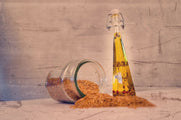Raw Dog Food Pet Dinners
If you are reading this, you have probably heard from somewhere that feeding your dog a raw diet is a good thing. Here at Rawmate we certainly believe that feeding raw dog food - if it is done correctly - is superior to any other form of dog nutrition. We didn’t just make that up. In this article we’ll tell you why we came to that conclusion and what we’re doing to make sure our meal plans for dogs provide all the nutritional elements your dog needs to thrive.
Raw Dog Food Makes Sense
It’s not a stretch to think that feeding dry, processed kibble might not be as palatable as feeding fresh, raw food. I mean, real food just looks and smells better. If you did an experiment or two and offered your dog a raw meal, chances are he’s not going to turn up his snout and wander off. If your dog is like most, when offered a raw food meal, he probably gobbled it up. But when you are investigating the best options for pet dinners it’s not enough to read anecdotal reports of happy dogs scarfing down chunks of lean lamb. It’s important to understand what a dog needs to eat in order to thrive and be healthy at different stages of life. Sure, it may seem like a noble idea to toss a freshly killed antelope in the backyard and let your dog tear it to pieces like her wolf ancestors might have done. Such a vision of returning to your dog’s true nutritional roots and feeding your dog naturally might even be the reason you are finding yourself here reading this article. But let’s take a paws and have a look at the science. What does your dog need in a properly balanced dinner? And how can you make sure the meals you are feeding your pup are not going to be lacking in some essential nutrients given that it’s not that easy to find a whole antelope at the local grocery store.
It’s Not So Easy to Emulate Mother Nature
In the wild, wolves consume a range of prey animals and each provides a slightly different set of nutrients. The entire animal is eaten including delicacies like the brain and tongue. Stomach contents are also consumed as are berries and greens (you’ve seen your dog snacking on grass, right?). Feeding a lump of ground beef every day won’t provide your dog with everything she needs no matter how much she enjoys the meal. This is the problem with trying to simplify a primal or prey menu by feeding only muscle meat or limiting the diet to one type of meat source.
What Does the Science Say about Raw Pet Dinners?
Several studies have shown (I’ll list some studies at the end, if you’d like to do some additional reading) that a dog’s digestive systems is designed to handle high protein diets with lots of moisture, fats and fibre and very little starch content. Knowing that, kibble looks less and less attractive. Highly processed dry dog foods are often loaded with high-carb fillers like wheat and corn and dogs who eat kibble have different gut bacteria to those who are fed raw or lightly cooked diets. The result of feeding a kibble-based diet is also seen (logically) in the size and consistency of poop produced. Dogs fed raw diets produce less poop and their faeces contain lower levels of volatile fatty acids. Studies in Finland show that dogs who eat raw meals have lower levels of inflammatory and disease markers and a New Zealand study concluded that a raw diet changed the makeup of the gut bacteria in such a way as to suggest better protein and fat digestibility in dogs fed raw meals.
Putting the Science into Raw Dog Food Meal Plans
While the studies indicate your dog is better able to digest raw meals, the real challenge with raw diets is to make sure your dog is getting the correct balance of nutrients. Dr Karen Becker suggests it’s important to include a wide range of fresh foods like blueberries, chia and hemp seeds, raw pumpkin seeds, certain fermented vegetables as well as sources of essential vitamins and other nutrients. In Australia, there are no regulations stating exactly what should be included in a nutritionally complete and balanced raw dog food meal plan or even just pet food (raw or otherwise). In the United States, standards clearly state what’s required and, by law, one can’t say a food is Complete and Balanced unless you meet those standards.

At Rawmate, we are careful to meet the standards established by the American Association of Feed Control Officials (AAFCO), something that I’m sad to say not all our competitors feel the need to do (this blog post discusses AAFCO standards in more detail). At Rawmate we’ve read the research papers and we know it isn’t enough to just feed lumps of raw meat to our dogs and that’s why we are so meticulous when it comes to formulating each and every pre-portioned raw dog food meal plan destined for your dog’s dinner bowl.
No Two Dogs Quite the Same
The thing is, though there are certain things all dogs have in common, every dog is also unique. A dog’s age, breed, activity level, hormone level, as well as factors like environmental toxins and stress all impact a dog’s unique nutritional requirements. At Rawmate, we ask you a lot of questions about your dog so we can be sure to prepare meals that don’t just keep your dog alive but allow him to thrive.
Can You Source Your Own Raw Dog Dinner Ingredients for Dogs?
Could you be doing this on your own? Sure. You can hunt down all the ingredients and weigh and measure and make sure your dog is getting all the essentials needed to keep her happy and healthy. Just make sure you are providing all the necessary antioxidants, trace minerals, vitamins, and not just the right fatty acids, but the right fatty acids in the correct proportions. Likewise, the balance between calcium and phosphorous is just as important as having enough of one or the other.
Do-It-Yourself Raw Meal Plans for Dogs
If you are going to go the DIY route, make sure you include muscle meat as well as organ meat, vegetables and fruit as well as appropriate vitamins, minerals, and probiotics. The diet should be made up of about 80% meat, organs and bones and about 20% veggies and fruits in order to provide adequate amounts of roughage and antioxidants. Supplements to ensure correct levels of zinc, iodine, copper, potassium, vitamins, and amino acids are a bit easier to incorporate into the diet than whole food sources of these additional nutritional necessities, but don’t even consider doing without. If you are thinking about making your own raw food meals for your dog, the book Dr Becker's Real Food For Healthy Dogs & Cats: Simple Homemade Foods provides a thorough discussion of pet nutrition. Though the authors support an owner’s desire to provide a balanced diet, they don’t shy away from suggesting a quality prepared food is a better option than a hit and miss approach to feeding your dog. In other words, if you can’t commit to doing it properly, you are better off purchasing pet meals that are guaranteed to meet all your dog’s nutritional needs.
No Shortcuts to Nutritionally Complete Raw Pet Dinners
Though it may be tempting to just feed ground up chicken (it’s quite economical), doing so won’t meet your dog’s most basic nutritional requirements. Raw meat does not equal a well-balanced and complete meal for your dog. The problem with feeding a sub-par diet is that problems don’t necessarily appear immediately. Nutritional deficiencies are insidious and creep up on your dog over time. That’s why it’s so important to feed a properly balanced and complete diet every day so your dog has the best chance to develop and maintain a healthy immune system and that all biological systems are fully supported for optimal health.

If you decide to go with a commercially-prepared raw dog food diet for your dog, make sure you do your homework and learn about the company and how they make their raw dinners. (Here’s a link to a post about how Rawmate sources fresh, human grade food and addresses the issue of food waste at the same time). What are the sources of protein? Vegetables? Fruits? What kinds of minerals, fatty acids, vitamins and micronutrients are included? A wide range of ingredient sources helps ensure the diet is actually going to meet the complex nutritional needs of your pets.
Is Raw Food Dangerous?
One of the warnings you may hear about when you are investigating whether or not switching to a raw meal plan for your dog is the danger of coming in contact with dangerous pathogens from raw meat. The fact is, we handle raw meat all the time, like every time you make burgers for the barbecue or prepare raw chicken for cooking. Handling raw food for your pet is no different. Wash your hands and sterilise any surfaces the raw food may come in contact with and you minimise your risks of being exposed to salmonella or other pathogens that can cause illness in people. Don’t be fooled into thinking that kibble can’t contain nasty bugs - dry pet food can also contain salmonella. Your pets are not affected by salmonella in the same way we are (many healthy pets harbour the bacteria), so be aware that kissing your dog on the lips is not necessarily the best idea if you are worried about getting sick.
What’s much more likely to cause an issue is feeding pet food that has somehow been contaminated (read our blog post about this subject here).
Rawmate Raw Meal Plans for Dogs
At Rawmate we are leading the pack when it comes to providing nutritious, healthy meal plans for dogs intended to optimise your dog’s health and not just meet bare minimum standards.
Feeding human grade food means our top quality meals are simply the best you can buy for your canine companions.
They depend on you to do the research and make the best decisions on their behalf. You can depend on us to make sure we are making the best quality raw meals for your faithful companion.

Speaking of research, here are some links to related studies, as promised:
By Alison N. Beloshapka, et al.
Current state of knowledge: the canine gastrointestinal microbiome.
Seema Hooda, et al
Raw, lightly cooked extruded dog foods alter gut bacteria (Article from PetFoodIndustry.com)
Raw meat based diet influences faecal microbiome and end products of fermentation in healthy dogs
Misa Sandri, et al
Key bacterial families (Clostridiaceae, Erysipelotrichaceae and Bacteroidaceae) are related to the digestion of protein and energy in dogs by Emma N. Bermingham, et al
Please, like, share & subscribe - We love talking with humans about their dogs. It's what we do.







There are 0 Comments